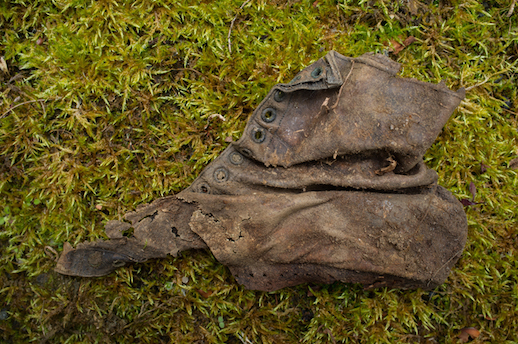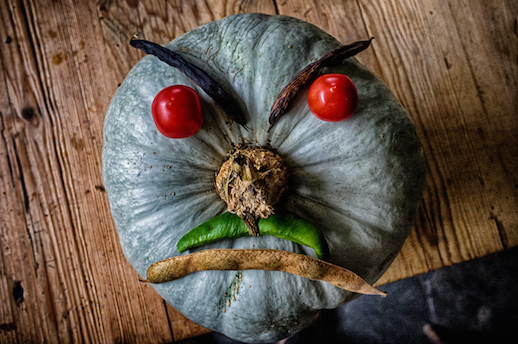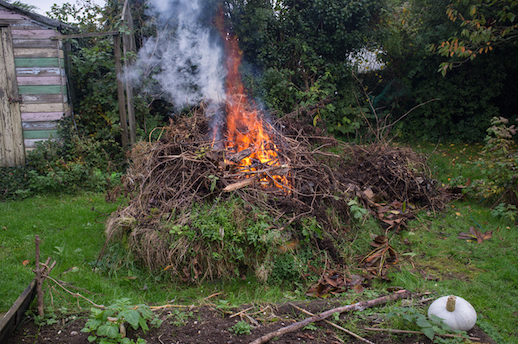Victorian superstition rears its head in the Cornish garden
Words and pictures: Stephen ‘Spoonful’ Parker
I raise the axe and bring it down, smashing the back over and over again on the heap of sweetcorn stems that need to be broken down for the compost heap. It’s a repetitive and cathartic thud, thud, thud. Nothing delicate about this part of the gardening year.
As I’m pausing for breath, I notice some nasty weeds growing in the old Cornish hedge that borders our garden, separating us from the field next door. The granite blocks could well have been there for 200 years. All the tugging at the weeds loosens one of the smaller stones. Pushing it back in, I spot something hanging loose in the wall. Another slight tug and what looks like material of some kind comes loose.
I give it a quick swill in the water butt, which reveals part of a leather shoe. A dressmaker friend inspects the tiny lace holes and stitching on the leather sole and thinks it’s Victorian. It’s tiny; a well worn female working boot. Usually old boots are found stuffed in the chimneys and doorways of houses – the entry points – to ward off evil. So did someone who lived here centuries ago stuff this boot in the wall as some form of superstitious boundary protection? I toy with melodramatic thoughts of what may happen with the boot removed from the wall. Should I put it back?
It’s Hallowe’en. My birthday. I’ve always loved this time of year. When I was young, my birthday and Guy Fawkes night were strongly intertwined. My birthday was on Hallowe’en, my best friend’s birthday on November 5th. It all happened in that dark exciting week when the clocks had been put back and the smell of Payne’s and Standard fireworks clung to the chill evening air.
During my birthday party, dad would sneak out into the dark and lurk in the garden. He’d hide in the bushes, shaking the branches, letting out ‘ghostly’ moans and groans. I don’t think we ever found him. We just ran around in the dark, chaotic autumnal night shouting with glee, wrapped in a comfortable fear. Then back inside for more cake and jelly and slightly bonkers indoor fireworks made by dad, with mum tutting over all the smoke and havoc created by my pyromaniac father.
My precious pumpkins have now been cut loose from their trailing vines and are sitting on the bare earth waiting for their skins to harden. I drop one of them and it rolls down a slope then bumps heavily down five granite steps. I pursue, fearing for its safety. Lying intact near the back door, it’s as hard as a cannon ball. If fired from a trebuchet it could take a wall down. I still, after 8 years of growing them, cannot fully understand my attachment to these huge beasts of the garden.
I decide that this pumpkin has selected itself for a Hallowe’en dressing up. There’s no way it can be hollowed out – the flesh of garden-grown pumpkins is far too dense, unlike the soft supermarket ones bred for lantern-making. So my daughter Berry and I set about sourcing the details for the face from the few remaining vegetables still hanging on in the garden and spend a lovely 20 mins trying to stop beans sliding off its face. He’s probably more comical than scary. I take a quick portrait and then nip out into the garden for a mooch around.
Berry’s nearly 13 now. Sitting at her place at the kitchen table she can see through the large window into the garden. From about the age of five she would talk about a figure walking across the garden with a dog. Every few months she would spot a tall man in a black coat and a short top hat walking quickly across the garden with a black dog on a black lead. At first I thought it was the product of her fertile young imagination – like her imaginary friend Mr Hakledoné and his sailor brother Monk – but the sightings continued for five years or so. Always walking quickly across the garden, only occasionally returning. Hmmm.
Cornwall has been blessed with a balmy October. More than four weeks of calm, still, warm weather makes up slightly for the terrible summer. It’s interrupted by one very cool night when the wind picks up, rain starts to fall and autumn seems to be making its pitch. Next morning the local corvids – the rooks and crows – make their presence felt. They are not known for their mellifluous sound. The hoarse, grating noise they produce puts them in the Oi! band category of bird musicians, stirring up a right old argy-bargy. But the following day the weather reverts to calm. The wind drops, the sun comes out and the birds fall quiet again. A false start.
I always keep an eye out for these birds flapping lazily across our sky. Sometimes they mob the local buzzards, but curiously this year the seagulls have taken over the job of bullying away the local pair. In his book Crow Country, Mark Cooper refers to a study by a GP, Mr Franklin Coombs, who lived in Falmouth in the 1930s. He observed the roosting corvids on the Enys Estate, Cornwall’s oldest recorded garden which is very close to the house, just away over the fields behind the boot wall. It’s part of a landscape that has changed very little since the Domesday Book. Dr Coombs noted the birds’ flight paths to and from the roost, and over the years built up a map of their fixed flight lines radiating back and forth from Enys as they went about their corvid business.
So when I hear the rattling, rasping noises from the shadowy gangs mustering in the trees or flapping slowly overhead, I imagine their Domesday relatives waiting for that moment in the year when the breeze picks up, the sky turns a welcoming shade of grey, and the leaves start to fall. I decide, with a half-way decent birthday hangover, that like my dad a thousand times before, to go outside on this grey but warm afternoon, stare up at that autumnal sky and have a bloody fantastic bonfire.


